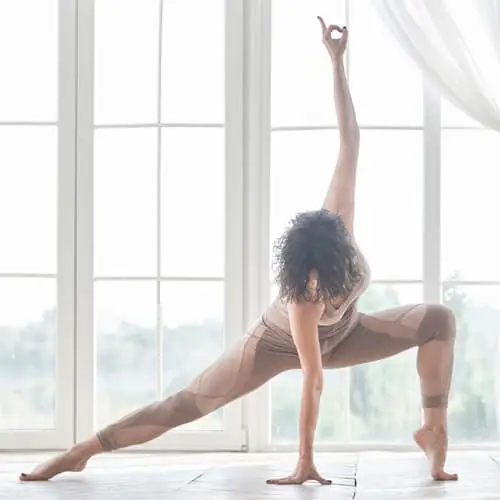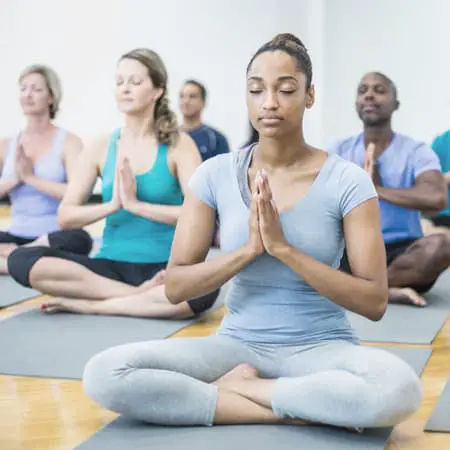Many people think that yoga and meditation are the same. In comparison, there are indeed similarities between them, but they are not the same thing. There are many important differences between these two practices.
Meditation can be considered a part of the yoga lifestyle. Meditation involves the pursuit of mental stability, while yoga involves both physical and mental exercise. The practice known as yoga primarily involves poses and breathing exercises, while meditation is about concentration.
If you are interested in taking up either meditation or yoga (or both), you are likely to see a variety of improvements in your life. Read on to find out what yoga and meditation are and the benefits and differences between these two life-enriching practices.
What Is Yoga?
The word “yoga” means “union” in ancient Sanskrit. Specifically, this is the union of the person who is performing the practice with the universe’s higher powers. When someone talks about doing yoga, they are not only referring to the union of these entities but the process of achieving this spiritual union.
The practice of yoga is a set of physical, mental, and spiritual exercises that originate from India. It involves various poses and breathing exercises. When someone tells you that they are “doing yoga,” this is what they mean. There are many different types of yoga that one can explore; some are more difficult than others.
There are many types of yoga poses as well. There are relaxing poses (such as forward bends and supported back) and activating poses (such as arm balances and sun salutations).
In yoga, the activating poses are often practiced at the start, in order to stimulate the sympathetic nervous system (fight or flight response). They alternate with the relaxing poses, which activate the parasympathetic nervous system; this allows the person to go back to a calmer place.

However, there is much more to yoga than this. Yoga is actually a lifestyle; it is a holistic approach that focuses on the health of the mind, body, and spirit. Yoga is known to have eight limbs; these are:
- Yama
- Niyama
- Asana
- Pranayama
- Pratyahara
- Dharana
- Dhyana
- Samadhi – spiritual absorption
The physical practice of yoga is meant to help people progress through physical and emotional tension. In some cases, it can be seen as good preparation for meditation.
What Is Meditation?
Meditation is actually a part of the lifestyle that is referred to as yoga; in fact, it is the seventh limb of yoga (Dhyana). The practice of meditation involves making the mind tranquil and becoming very aware without focusing on any specific thoughts. The aim is to reach a higher level of consciousness and enhance the stability of the mind.
The purpose of meditation is mindfulness and complete connection with only the present moment, rather than letting other distracting thoughts impact your mental state at the time. It often involves a complete focus on one object or symbol. Meditation can be much more challenging than one might believe before trying it.
Even though there is a difference between meditation and yoga, the ultimate goal of both is to bring peace of mind and a feeling of oneness with other living beings.
The Differences Between Yoga and Meditation
Obviously, yoga and meditation have elements in common; both are meant to improve the person’s mental and spiritual health who is engaging in the activity. However, as meditation is only one part of yoga, there are differences as well. Though meditation is an essential limb of yoga, there is much more to yoga that is also important to the practice.
End Goals
It should come as no surprise that yoga is more holistic than meditation. The end goal is not only mental stability but also physical and spiritual stability. Yoga focuses on both internal and external stability, while meditation focuses primarily on the person’s state of mind.
Activity Level

Meditation is almost entirely mental. In most cases, there is little movement involved in meditation. Meditation is all about exercising the mind rather than the body. When you meditate, you learn to relax, self-reflect, learn, and connect with your surroundings. Physically, you do not have to exert yourself and can rest your body while you meditate.
Yoga, in contrast, involves a great deal of focus on movement. Yoga is considered a form of exercise. There is a lot of concentration on breathing patterns and different positions of the body. Like meditation, yoga is also designed to benefit the mind, but the mental effects are not quite as strong as they are with meditation.
In fact, many people find yoga to be physically challenging. You need to maintain breathing patterns and be able to put your body in some difficult positions, but you also need to maintain balance and internal peace and focus. Many people might think that this is easy, but shifting through yoga poses can be hard work, to the point where it makes you sweat.
The physical aspect of yoga is a form of mindfulness in itself. A significant goal of yoga is to stay connected to the present moment (just as you would while meditating) while moving between poses and maintaining poses. This can be more challenging than a meditation that does not require movement.
In addition to positive effects on mental state, yoga has many positive effects on physical health, such as better cardiovascular health, muscle strength, flexibility, and weight loss. It can help people who are dealing with different types of pain and stiffness.
Restrictions
Because of the two practices’ respective natures, there are fewer restrictions on who can meditate than who can do yoga. For example, some asanas (body postures within yoga) cannot be done on an empty stomach. There are also positions that some people may not be able to do if they have specific health issues.
However, this is not to say that meditation is easier than yoga in every way. There are some people who may be unable to meditate because of certain physical or psychological issues. They may actually find it easier to engage in physical asana practice; for them, this may be the easiest path to mindfulness.
Benefits of Yoga and Meditation
Essentially, if you start a regime that includes meditation and yoga, you can expect better health in many ways. There are many benefits that come with both practices; they are as follows:

- Better spinal flexibility
- Better health of the bones, joints, and muscles
- Improvement in rheumatoid arthritis
- Improvement in headaches, migraines, and hangovers
- Better cardiovascular health
- Reduced severity or recovery from asthma
- Better digestion and metabolism
- Better and more restful sleep
- Better emotional health (more stable emotions, better stress management)
- Improvement in brain function (including memory, concentration, and mental clarity)
- Increased flexibility in the muscles and joints
- Higher self-esteem, leading to better self-care
- Improvement in overall health from a holistic perspective
Summing Up
Yoga and meditation are both very good for the body and soul. While meditation is considered a limb of yoga, when people talk about meditation and yoga, they talk about two different practices. Meditation is a mental practice where you train your mind to focus and not be distracted by unwanted thoughts, whereas yoga is a set of poses and breathing exercises.
Many people would do well to incorporate either or both of these practices into their lives on a regular basis. A lifestyle that incorporates yoga (including meditation) can be a very happy and well-balanced one.








